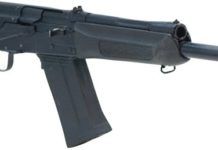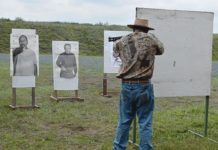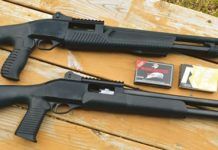Back-to-the-basics shotguns featuring black composite stocks and forearms fill a special niche in the world of scattergun enthusiasts. These firearms are picked for their ability to serve as a shooting tool that can withstand rugged hunting conditions and not with a lot of attention to appearance. They also eliminate the possibility of a flash of sunlight glinting off a shiny stock or barrel and alerting incoming waterfowl of potential danger.
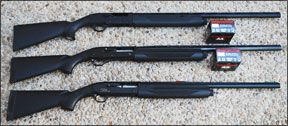
Most of the major manufacturers offer at least a few of their shotgun models featuring composite stocks and forearms and non-glare barrels, and a variety of the shotguns make their way to the used gun racks where shooters are looking to pick up a bargain.
The three used composite semiautomatic shotguns we gathered for our test included the Smith & Wesson Model 1012, $630; the Winchester Super X Model 2, $600; and the Browning Gold Hunter, $700. While the trio’s prices are probably in the moderate-to-high-end range for a used semiautomatic, we picked them as a good representation of how composites compared in the field and on the range.
The Winchester Super X2 is the same model reviewed by Gun Tests in March 2004, when it was pitted against a Mossberg 935. The Winchester was our pick in that match-up. In addition, we looked at a Super X3 versus a Benelli M2 in November 2007 and also gave the Winchester model a thumbs up in that comparison. In both cases, we were pleased with the Winchester’s handling ability; functioning features; and the speed of the action over the other shotguns in those tests.
This latest match up involved two more recent introductions into the composite stock and forearm world of shotguns, and we were interested in determining how the veteran Winchester would fare.
To check out the shotguns in a variety of shooting situations, we selected the following test ammunition:
For clay targets, we used Winchester AA Light Target 23⁄4-inch loads with 11⁄8 ounce of No. 8 shot and an average muzzle velocity of 1145 fps; and Winchester Super Sport Sporting Clays 23⁄4-inch loads with 11⁄8 ounce of No. 71⁄2 shot and an average muzzle velocity of 1300 fps. It should be noted that none of the three shotguns would function well with the light target loads, resulting in numerous failures to feed a second shot. These shell-feeding problems were eliminated when we switched to the hotter sporting clays shells.
For the patterning tests, we selected Federal Steel Duck and Pheasant 3-inch loads with 1.25 ounces of BB shot and a muzzle velocity of 1300 fps. No functioning problems were encountered with any of the shotguns when firing the 3-inch shells.
We also function-fired several 31⁄2-inch shells, Estate High Velocity Magnum Steel with 13⁄8 ounces of No. 4 shot and an average muzzle velocity of 1,500 fps. We wanted to see how the Browning and Winchester would handle the heavy loads. The Smith & Wesson is limited to no more than 3-inch shells.
While there were no functioning problems, there was quite a bit of shoulder shock when firing the 31⁄2-inch loads in the Browning. Probably because of the Winchester’s heavier weight, there was no appreciable difference in recoil between 3-inch and 31⁄2-inch loads. However, we were happy to limit our practice time with the big shells to only a few rounds.
We were generally pleased with the way all three of the shotguns could be moved onto targets on the clays course and with the trio’s patterning performance using steel shot on paper targets set at a range of 30 yards.
Details of how each shotgun performed at the clay target range and patterning field follows in our report:
Smith & Wesson Model 1012 3-Inch 12 Gauge, $630
Returning to the shotgun market about four years ago, Smith & Wesson introduced the Model 1012 as a lightweight, yet durable, semiautomatic shooting tool. Made in Turkey, the shotgun is slim and trim, with a thin pistol grip that extends into a comfortable length that can accommodate even ham-fisted shooters. The white Smith & Wesson seal on the end of the pistol grip is a nice touch. True to its promotion, the shotgun tips the scales at just 6.5 pounds, but we were impressed with its heft and balance.
Featuring a 28-inch barrel, the Model 1012 was 48 inches long, with a length of pull of 14.25 inches; drop at the comb of 1.25 inches; and drop at the heel of 2.25 inches. All of our test shooters had no problems adjusting to the dimensions and as noted, we liked the way the shotgun felt and handled.
The mid-bead and red front sight allowed for easy sight alignment along the ventilated rib barrel.
We were disappointed in two features of the Smith & Wesson—the trigger-pull weight of 7 pounds (a gunsmith adjustment would be recommended) and the bolt locking lever. The lever is a little small and is located on the left front of the trigger guard. While we did manage to access the lever during our clay target shooting tests, shooters wearing gloves during hunting conditions might experience difficulty.
As noted above, the light target loads did not cycle in the Smith & Wesson, although it handled the hotter sporting clays loads and steel shot loads without a hiccup. This cycling problem with light target loads is common with many semiautomatics.
We were able to move through targets and smack clays with authority, earning the Smith & Wesson top marks from each member of our test team. The longer barrel seemed to provide for better target acquisition on the range, and we did not believe it would pose any handling problems in a waterfowl blind.
Using the 3-inch steel loads for the patterning tests, the Model 1012 consistently produced a 40-60 pattern at 30 yards, with 40 percent of the hits above the center of the target and 60 percent below. This is just a little low for some shooters, but the spread across the pattern target was very solid and would have provided a killing shot in most hunting situations.
Our Team Said: Slim and trim, plus being able to capably handle both the sporting clays target loads and 3-inch steel shells, earned this shotgun high marks in our test. The bottom line is that the Model 1012 is an affordable, very comfortable shotgun to shoot. Our only concerns were with the trigger pull, which we would recommend the owner take to a gunsmith for adjustment, and the bolt locking lever that might be hard to access when the shooter is wearing gloves.
Winchester Super X2 31⁄2-inch 12 Gauge, $600
The old warhorse of the test trio, the Winchester Super X2 is a time-tested shotgun that has been put into field duty by legions of waterfowl and game bird hunters.
It is a solid and dependable shooting tool made in Belgium, and was favored by the larger members of our test team because of its heavier weight. The Winchester was the heaviest of our test shotguns, weighing just over 7.5 pounds. Most of the weight is in the forearm, causing the shotgun to be slightly muzzle heavy.
On the plus side, this weight more typical of an over and under helped reduce recoil from the heavy steel loads and assisted shooters in pushing through targets. On the minus side, that extra weight can turn into a burden when the shotgun has to be carried for any length of time.
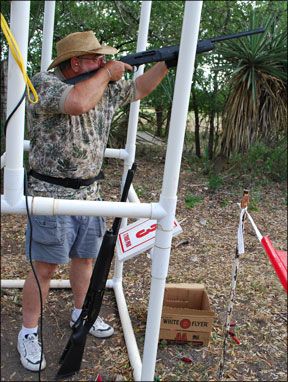
Sporting a 26-inch barrel, the overall length of the Winchester was 46.75 inches, with a length of pull of 14 inches; a drop at the comb of 1.5 inches; and a drop at the heel of 2 inches. The shorter LOP caused only minor adjustment problems, although it should be noted that in shooting conditions where heavy clothing is required, the fit would be better.
While we were not dissatisfied with the heft and feel of the Winchester, it was just less smooth than the other two shotguns in the test. “Just a little clunkier” was the way one member of the test team described the Super X. Catching up to close, fast clay targets or handling darting and diving teal coming into a spread might be a little more difficult because of the Winchester’s forward weight and overall balance.
As with the Smith & Wesson, the trigger pull was a little more excessive than we would like, breaking at 6.5 pounds. Once again, a little gunsmith work would remedy that problem.
There were fewer hang ups with the Winchester with the light target loads, although many of the shells failed to cycle, than with the other two shotguns. As noted earlier, functioning problems were eliminated when the hotter sporting clays loads and the steel shot loads were put into play.
On the patterning board, the Winchester caused us a little concern—producing a 30-70 pattern on a 30-inch circle set out at 30 yards. With only 30 percent of the shot hitting above the center of the target, we recommend that a shooter test additional types of ammunition to attempt to achieve a more desirable 50-50 pattern.
Our Team Said: While the overall review of the Winchester was good, we could not give it a top rating because of the shotgun’s weight, heavy trigger pull and patterning performance. However, there is no doubt that the Super X2 is a dependable workhorse for waterfowl and field hunters. For those who don’t mind a little extra heft and are willing to have a gunsmith tweak the trigger pull, this is a fine firearm worthy of consideration.
Browning Gold Hunter 31⁄2-Inch 12 Gauge, $700
With a reputation as one of the best-pointing semiautomatics on the market, the Browning Gold Hunter is hard to beat in handling.
Made in Belgium and assembled in Portugal, the older version Browning Gold Hunter we selected for this test was short, compact and a pleasure to shoot—with lighter loads.
Sporting a 24-inch barrel and measuring just 45.25 inches, the Gold Hunter was easily the quickest-handling shotgun in the match up.
With a length of pull of 14.5 inches; a drop at the comb of 1.5 inches; and a drop at the heel of 1.75 inches, this shotgun was very comfortable to shoot.
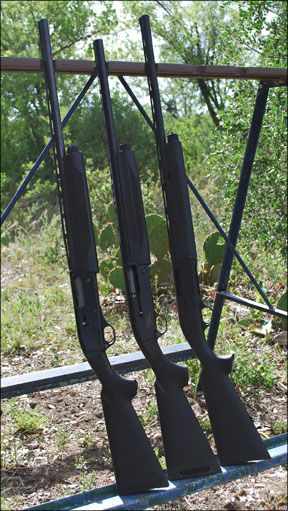
We were surprised at the weight of the Browning, which tipped the scales at 7 pounds, however, unlike the Super X2, the balance of the shotgun was more between the shooter’s hands than in the forearm. This allowed for the shooter to pick up quick, close targets a little faster than with either of the other test shotguns.
The trigger pull weight of 5.25 pounds was the best of the trio and the crisp, clean let off was appreciated by our test team. A lighter trigger pull is not as important on a shotgun as it is on a rifle, but in both cases, the smooth, light pull with help prevent a shooter from pulling off a target.
Two of the features we particularly noted in the Browning were the magazine cut-off lever on the left side of the receiver (a tool that can be quite helpful in handling waterfowl shooting situations where different loads need to be quickly brought into play depending upon the incoming species); and the large ambidextrous safety on the back of the trigger guard. Utilizing both features, even when wearing gloves, would not be a problem for shooters.
Loading the Browning was also easier than the other two shotguns, as the speed-loading feature where a shell placed in the magazine is automatically fed into the open chamber was effective with all of the test ammunition. Although we were initially concerned with how the handling ability of the Browning would be impacted with its 24-inch barrels, we encountered no problems with even long-distance targets on the sporting clay range. Once again, the lighter target loads would hang up in the Browning, but the hotter sporting clays shells worked just fine.
We also noted that the Browning ejected all of the test ammunition farther and with more authority than the other two shotguns. Even the 3.5-inch loads, which produced some uncomfortable shoulder shock, functioned well in the shotgun.
On the patterning board, the Browning produced a very nice 50-50 spread with the 3-inch steel shot. It was uniform and consistent, providing a killing pattern that would be effective on all types of waterfowl.
Our Team Said: A proven shooting tool in both clay target and field conditions, the Browning Gold Hunter worked well, handled well and was a pleasure to shoot, except with the 31⁄2-inch shells. The excessive recoil caused by the heavy loads, in addition to its slightly higher price tag over the other two test shotguns, were two minor downsides to this very fine shooting tool.



























